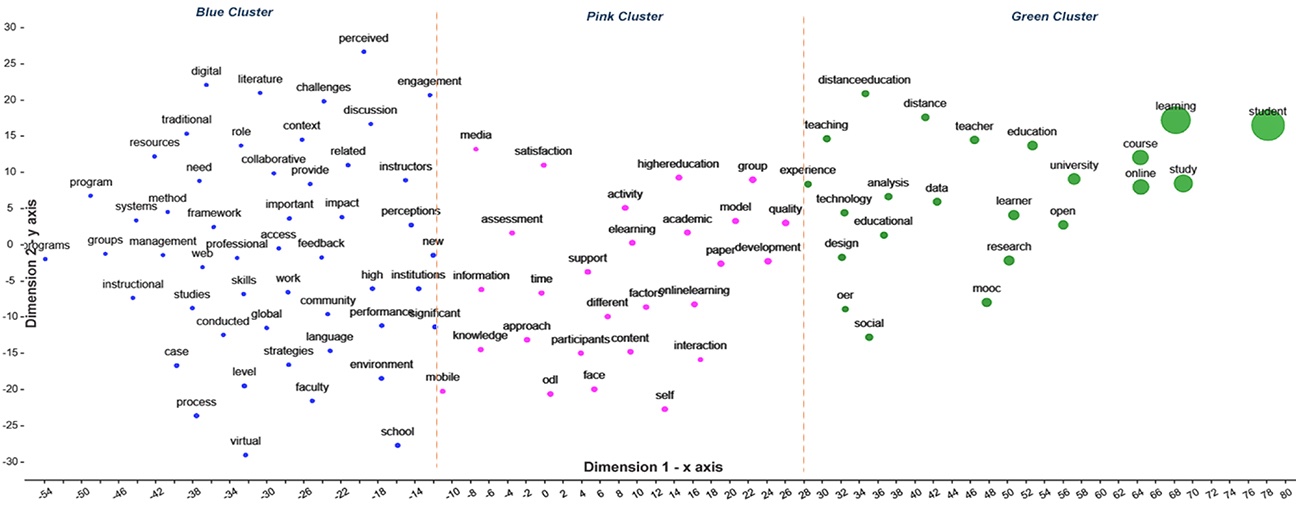
Volume 22, Number 2
Aras Bozkurt1 and Olaf Zawacki-Richter2
1Anadolu University & University of South Africa; 2Carl von Ossietzky University of Oldenburg
The field of distance education (DE) is dynamic and constantly evolving; it reflects and adapts according to changes in socio-cultural, demographic, political, and technological domains. Thus, there is a need to understand past and present activities in the field, in order to better inform future research. The main purpose of this study was to examine DE research through data mining and analytics approaches, using social network analysis (SNA) and text mining to conduct a bibliographic analysis. The findings highlighted three main strands of DE research: (a) issues related to open education; (b) the design, support, and quality assurance of online DE; and (c) the implementation and use of educational technology, media, and digital tools. SNA of the bibliometric data identified pivotal theoretical contributions, including that the fields of distance education and educational technology converge. The article concludes with recommendations for future research directions.
Keywords: distance education, open and distance learning, open education, online learning, research patterns and trends
The field of distance education (DE) has long been dedicated to providing flexible ways for a wide diversity of learners to access knowledge and learning opportunities. In particular, for generations the field has benefited from the use of educational technologies (EdTech) to provide a variety of educational opportunities to learners beyond traditional paper-based study materials (Bozkurt, 2019; Moore & Kearsley, 2012; Zawacki-Richter & Naidu, 2016). Over time, DE has adapted and developed DE-specific curricula, educational strategies, and learning models that meet the needs of learners, by taking advantage of increased capacity and affordances of prevalent technologies. Following the advent of computers, online technologies, and online networks, as well as socio-cultural, demographic, political, and technological shifts all over the world, DE has metamorphosed as online learning and emerged as a mainstream educational model, rather than being peripheral or supplementary. Years of experience in the theory and practice of DE have provided a clear pathway for the transformation of higher education due to changing characteristics of teaching, learning, and educational institutions. DE proved its value during the interruption of education due to the COVID-19 pandemic; further, the field of DE has been a significant change agent in the digital transformation of higher education.
In the digital age, affected by the globalized knowledge-intensive economy, 21st-century learners demand ubiquitous, personalized, flexible, and socially collaborative educational experiences; DE has striven to meet these aims by merging theory and practice, and implementing educational technologies where appropriate and relevant. The dynamic nature of DE requires a broad, multidimensional understanding of the past and present evolution of the field, not only to understand past trends but also to anticipate future needs and opportunities. It is vital to gain deeper insights into the constantly changing characteristics of learners, learning, educational technology, and educational institutions. In order to embrace change, enable smooth transitions during the phases of transformation, and more importantly, to be resilient, agile, and adaptive, we need to know how the field of DE has framed and processed scholarly knowledge. This research study aimed to map and visualize the intellectual landscape of the DE field and synthesize the findings of scholarly publications by analyzing scientific networks.
Scholarship is based on the notion that to better predict the future of a field of study and navigate through it, one must first look at its past. In this way we can gain insights by tracking the growth and progress of a field in terms of scholarly publications and reflect on what makes these insights valuable. The following section describes some earlier works that sought to analyze the field and provide a base for future directions by distilling past and present aspects of DE research.
Zawacki-Richter and Naidu (2016) suggested that “online educational technologies will play a critical role in education broadly, and especially in relation to an education for all agenda” (p. 264). Similarly, different authors have claimed that EdTech (Sim, 2017) and instructional design for online learning have triggered the advancement of DE (Çakiroğlu et al., 2019) and moved online distance education from the periphery to the centre of higher education (HE) offerings (Xiao, 2018). Naidu (2019) further emphasized that it was not the mere contribution of technology, but learning methods, approaches, and strategies that were transforming distance education. Providing a base and justification for this area of research, Xiao (2018) highlighted DE’s value, validity, and central role in HE, and argued that there was a need to “reflect seriously and constantly on what to do next” (p. 269).
Some studies have explored change and transformation in DE research. Highlighting that until the 2000s, DE research was criticized harshly for a lack of robust empirical research, Berge and Mrozowski (2001) reported that from 1990 to 1999, common concerns in DE publications were pedagogical topics such as “design issues, learner characteristics, and strategies for active learning and increased interactivity” (p. 17). The same authors also noted the importance of identifying research gaps and providing a research agenda in the DE field, which provided a rationale for the studies that followed. Lee et al. (2004) examined DE publications from 1997 to 2002 and recommended that “new research methodology and paradigms are needed to advance distance education research” (p. 17). They further noted that topics related to learning design were dominant at that time, which may be attributed to the changing characteristics of learning technologies and environments. Zawacki-Richter et al. (2009) investigated publications from 2000 to 2008 and showed that the focus of DE research had shifted toward “interaction and communication patterns in computer-mediated communication, instructional design issues, learner characteristics, and educational technology” (p. 20). Bozkurt et al. (2015) analyzed studies from 2009 to 2013 and found that online learning had gained great momentum, and openness in education was becoming an obvious research interest. They highlighted the finding that learner and learning-centered topics were the focal points in DE research at that time, and they noted further that dominant research areas were (a) educational technology, (b) interaction and communication in learning communities, (c) learner characteristics, and (d) instructional design. One thing these studies had in common was recognition of the increasing influence of digital or online technologies, which tended to open up education, and built an intertwined relationship between DE and EdTech.
Change is continuous, so it is necessary to examine trends and patterns, and build upon previous research. Thus, structural gaps and weak points in the area can be identified and buttressed. Such an approach is vital for improving the field on solid ground and navigating through uncertainty. Against this background, the main purpose of this research study was to explore and examine research trends and patterns in the field of DE between 2014 and 2019. This study sought to answer the following research questions:
This study applied data mining and analytic approaches (Fayyad, et al., 2002) such as text mining (Feldman & Sanger, 2007) and social network analysis (SNA; Hansen et al., 2010; Scott, 2017) to explore publication patterns and thematic trends in DE research between 2014 and 2019. We used text mining to analyze the titles and abstracts of 1,362 peer-reviewed publications, and SNA to analyze keywords and reference lists of the publications in this research corpus. For benchmarking and reliability purposes, the software tools Gephi and NodeXL were used to perform SNA, and Leximancer to conduct text mining. The purpose of using multiple analytic approaches is to triangulate the data to increase the reliability and validity of the research findings (Thurmond, 2001), and to explore different layers of the research corpus to reach a broader view in addressing the research questions.
The journals for inclusion in the research corpus were selected based on the following three criteria: they were indexed in the Scopus database, were published in English, and had a strong focus on DE. Accordingly, the corpus consisted of the following six double-blind, peer reviewed journals: em>International Review of Research in Open and Distributed Learning (IRRODL), Distance Education (DE), Open Learning: The Journal of Open, Distance and e-Learning (OL), the International Journal of Distance Education Technologies (IJDET), the Turkish Online Journal of Distance Education (TOJDE), and the American Journal of Distance Education (AJDE). These journals were considered representative of the field and had been featured in earlier studies (Gomes & Barbosa, 2018; Zawacki-Richter & Anderson, 2011). In following up on Bozkurt et al. (2015), who reviewed the field from 2009 to 2013, we defined the year 2014 as a starting point. As a result, a total of 1,362 articles published between 2014 and 2019 in the six journals were selected for analysis (see Appendices A and B for details on these journals).
After building the research corpus, four separate analyses were conducted. First, titles and abstracts of the selected articles were analyzed using t-distributed stochastic neighbor embedding (t-SNE) to visualize “high-dimensional data by giving each datapoint [words in titles and abstracts] a location in a two [ sic ] or three-dimensional map” (van der Maaten & Hinton, 2008, p. 2579). Second, social network analysis (Scott, 2017) of the keywords was performed to better identify thematic clusters and significant nodes with strategic positions in the keyword network. In this analysis, each keyword identified by the authors of the article was considered a node and their co-occurrences considered a relationship. Third, lexical analysis of the titles and abstracts was performed to visualize a thematic concept map and to identify major themes emerging from the research corpus. Lexical analysis “employs two stages of co-occurrence information extraction—semantic and relational—using a different algorithm for each stage” (Smith & Humphreys, 2006, p. 262). In the fourth and final stage, social network analysis was used to examine the references and citation patterns in the articles in the research corpus. Accordingly, “citing articles and cited articles are linked to each other through invisible ties, and they collaboratively and collectively build an intellectual community that can be referred to as a living network, structure, or an ecology” (Bozkurt, 2019, p. 498). Chen (2006) further argued that pivotal contributions in the scholarly landscape can be identified through their ability to answer critical and needed questions; their strategic position can be estimated in terms of impact which, in turn, can be measured by means of bibliometric metrics. In this regard, the final stage of analysis examined scholarly progress in the DE field by identifying pivotal contributions and turning points.
The strength of this study was in its methodology and scope. First, the research built a representative research corpus by including full data from six sampled DE journals. Second, the research used computer-based data visualization techniques to better interpret the large volume of research data collected. Third, triangulation of research data enabled the exploration of different dimensions of the DE field, thus yielding a broader view of the field. However, some limitations need to be acknowledged. First, despite the representative research corpus constructed, DE-related articles are also published in various other formats, and thus this study provided only a partial view. Second, the findings were based on the data extracted from six double-blind, peer reviewed journals and limited to publications written in English.
To address the first research question, three types of complementary data analysis explored the thematic structure and research topics in the 1,362 articles that made up the bibliographic corpus of this study. The three analyses—t-SNE analysis of titles and abstracts to identify major research topics, SNA of keywords, and content and co-word analysis—are described in detail below.
In order to provide a first rough description of the focal points in DE research, t-SNE analysis was conducted based on titles and abstracts of the articles in the research corpus. t-SNE is an unsupervised “nonlinear dimensionality reduction technique that aims to preserve the local structure of data” (van der Maaten & Hinton, 2008, p. 2580), used for exploring and visualizing high dimensional data. The data set derived from the 1,362 articles produced 246,950 total words in 10,730 unique, singular word forms. From among these, the top 100 words with raw frequencies were included in the t-SNE analysis. The settings for t-SNE were adjusted as follows: cluster value: 3; dimension value: 2; and perplexity value (probability distribution): 75.
Figure 1
t-SNE Visualization of Article Titles and Abstracts

*Note. The size of a circle indicates the frequencies of the nodes. Click here for a larger version.
Figure 1 illustrates three major clusters identified in the research corpus, depicted, from right to left, as green, pink, and blue. The salient cluster that emerged with the highest raw frequencies (green cluster) indicates that—in the broadest sense—the focal points of authors publishing in DE journals were student learning in an open, online course environment (i.e., student, learning, online, course, open, MOOC), and using educational technology to design teaching and learning experiences.
The majority of research was undertaken in a higher education context (i.e., university in the green, and higher education, academic in the pink cluster), in contrast to DE and technology-enhanced learning in school settings (i.e., school in the blue cluster). This result is in line with findings by Zawacki-Richter and Naidu (2016), who carried out a content analysis of the journal Distance Education over 35 years. They also identified students and learning as the two major topics in 515 articles that were connected via the thematic region of interaction. “Learning is seen in these articles as a social process that is facilitated by interaction among participants” (Zawacki-Richter & Naidu, 2016, p. 249). The current findings showed that in order to facilitate interaction, technology was used in DE to design high-quality learning opportunities (i.e., technology, interaction, media, design, teaching, social, and engagement in the green, pink, and blue clusters).
Quality in open and distance learning is another important concern of researchers in the field. Student support systems, high-quality content, and interaction are important factors related to quality assurance and development (i.e., quality, support, content, and interaction in the pink cluster). Prerequisites for high-quality online learning and teaching include institutional strategies and policies for digital education, support, and resources to overcome the challenges of innovation and change. Professional training for faculty members and teachers is critical for them to develop the necessary skills to design and facilitate meaningful online learning experiences (i.e., institutions, strategies, challenges, professional, skills, and faculty in the blue cluster).
SNA provides insightful solutions to map, summarize, and visualize networks as well as identify key nodes that occupy strategic positions in these networks (Hansen et al., 2010). Keywords are representations of the articles at the granular level, highlighting their thematic scope. Of the 3,383 keywords in the 1,362 articles, those with a minimum occurrence of three were included in the analysis—a total of 282 keywords (see Appendix C for the top 40 keywords). Essentially, SNA examines nodes and their relationships—in this study, these were the keywords and their co-occurrence. The analysis revealed eight major clusters concerned with (a) delivery modes, (b) learning environments and contexts, (c) theories and concepts, (d) technology and media, (e) variables, (f) target groups, (g) research methods, and (h) miscellaneous territorial keywords. Figure 2 illustrates the SNA results; each cluster is discussed in more detail following Figure 2.
The first cluster of keywords describes various delivery modes depending on the degree of digitisation: (a) technology-enhanced learning; (b) e-learning; (c) mobile learning; (d) blended or flexible learning; and (e) online, distance learning. The analysis showed that the concepts of open education and open educational practice played an important role in the publications. This was not surprising, as open and distance learning have been closely related to each other throughout the history of DE (Zawacki-Richter et al., 2020).
Cluster two is related to DE settings, contexts and learning environments. The findings confirmed that the publications focussed mainly on the higher education context, with less emphasis on K-12 school settings. Articles in this area dealt with learning environments that can be formal (e.g., an institutional learning management system) and informal (e.g., social networks like Twitter, Facebook, or other Web 2.0 tools). Again, the concept of openness played a prominent role, with open access applications and open textbooks seen as important tools and resources for the design of learning environments and networks.
Figure 2
SNA of Keywords, Showing Eight Clusters
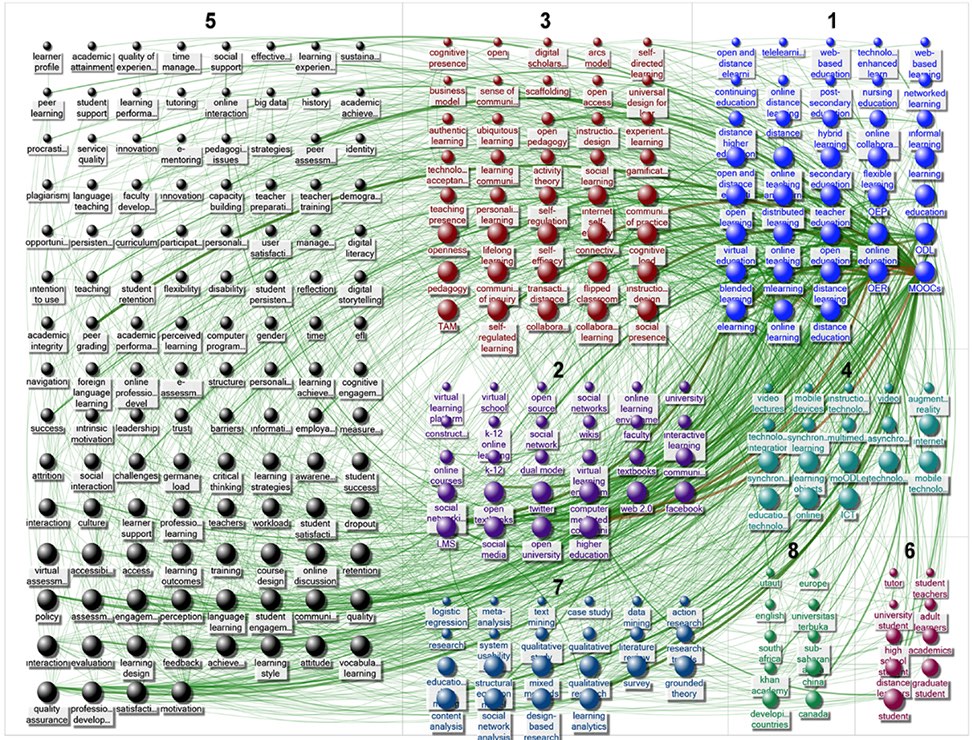
The third cluster provides an overview of the theories and concepts applied in DE studies. Perhaps the most influential theoretical framework for online learning has been that of Garrison at al. (2000), the community of inquiry (CoI) model with its core elements of social, teaching, and cognitive presences—all these were among the top keywords in this area. As distance education promotes independent and autonomous learning, self-directed and self-regulated learning theories formed the foundation of many articles. On the other hand, many researchers were concerned with questions about how distance learning can be made more interactive, and how to facilitate communication with students and teachers in order to build a sense of community. These ideas resonated with Lave and Wenger’s (1991) community of practice or Moore’s (1989) theory of transactional distance. Since distance education is facilitated by educational media and tools, technology acceptance model (TAM) was important concepts to measure their acceptance and usage by students and teachers.
The keywords in cluster four confirmed that DE was closely linked to educational technology, especially two-way media as a constituent element, as evident in Keegan’s (1980) definition of DE. Learning and teaching in DE have been supported by various synchronous and asynchronous media and tools; in particular, video-based formats have gained importance in the years that were analyzed.
Cluster five includes a wide range of input or output variables that studies have measured to evaluate and investigate learning designs (e.g., students’ attitudes and perceptions, their engagement and satisfaction, drop-out rates, or learning styles and strategies). Many of these keywords were related to issues dealing with student support and service quality, as well as students’ skills and individual traits. The need for teacher training was highlighted, particularly in terms of providing academic support and guidance to students.
Cluster six includes keywords related to target groups within DE, mainly adult learners, but also high school students. However, the majority of keywords in this area showed again that research focused on the higher education context (e.g., university student, graduate students, academics) as opposed to the school context.
Whilst research into distance education in its early stages was criticized as being “atheoretical and predominantly descriptive” (Perraton, 2000, p. 1), the keywords in cluster three and cluster seven indicated that current research methods have applied a wide range of theories, as well as qualitative and quantitative research methods. SNA and learning analytics, as well as design-based methods, occurred as prominent research approaches over the range of years included in this study.
The eighth and last cluster is related to miscellaneous territorial keywords. What was prominent here was the mission of the DE field to widen access to educational opportunities, especially in developing countries. These efforts were supported, for example, by the Commonwealth of Learning in Canada, and the open education initiative of the Khan Academy.
The findings of the SNA of keywords resonated with the t-SNE analysis of titles and abstracts, provided more details of the plethora of research topics under investigation. We now proceed to discuss the third method of analysis—a text-mining approach for content and co-word analysis.
Words gain their meanings in their context, and the implicit lexical relationship among words within texts can be revealed and visualized explicitly through text mining. For the purpose of the study, the titles and abstracts of 1,362 articles were analyzed and visualized through text mining using the Leximancer software tool. The software drew a concept map that revealed lexical patterns of concepts, grouped through relational co-word analysis in thematic regions (Figure 3). “The map is an indicative visualization that presents concept frequency (brightness), total concept connectedness (hierarchical order of appearance), direct inter-concept relative co-occurrence frequency (ray intensity), and total (direct and indirect) inter-concept co-occurrence (proximity)” (Smith & Humphreys, 2006, p. 264). Depending on the connectedness of concepts, a thematic region was formed (the colored bubbles) and named by the most frequent concept within this region.
Figure 3 depicts the overall concept map for the 1,362 articles in the corpus. The publications in the journals reported on four main themes, namely (a) research on the (b) design of (c) student online learning opportunities in (d) distance education in higher education academic settings.
Figure 3
Concept Map for 1,362 Articles Published in DE Journals Between 2014 and 2019
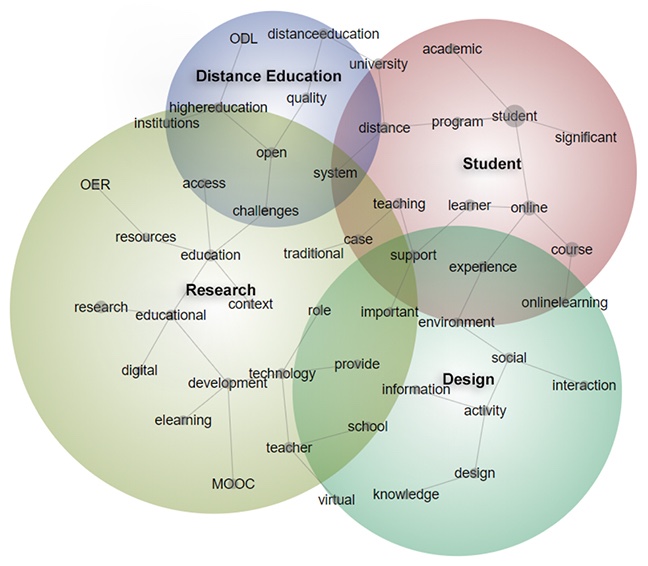
Openness and Access. Topics related to openness and open education were prevalent in the thematic regions of research and distance education (in Figure 3 see concept paths OER—resources—education—access, MOOC—development, and open—higher education—ODL). Meta-evaluations indicated that open educational resources (OER) promise a great deal in terms of multiple perspectives (e.g., transparency, communication, and engagement; Dalsgaard & Thestrup, 2015). However, challenges and quality issues were addressed by researchers in this thematic area—such as discoverability, sustainability, and remixing of learning materials (Luo et al., 2019); it has been further critically argued that we should first “remove the barriers from within” (Mishra, 2017, p. 378). Some authors argued that open educational practice (OEP) paves the way for OER, and openness should not be limited to OER issues only (Koseoglu et al., 2020). Similar to discussions on OER and OEP, MOOCs, for instance, emerged as an extension of openness in education. However, they have been highly criticized because of high dropout rates, motivational issues, and low instructional quality. Lambert (2020) argued that MOOCs and other practices rooted in openness in education should be praised for contributing to student equity, social inclusion, and widening participation. In fact, when we revisited the core values of DE, it was not quantified measures that defined its success, but rather quality and the degree of openness, flexibility, and learning opportunities through DE available for those who would not otherwise have access to education.
Digital Transformation of DE. DE and technology-enhanced learning have been evolving over time and closely related to innovations in the field of educational technology (see Zawacki-Richter & Latchem, 2018). Researchers paid attention to development, innovation, and change in the light of new and emerging digital tools and media to facilitate teaching and learning in DE (In Figure 3, see concept path technology—development—educational—digital). Globalization has challenged education in many ways, including the supply and demand chain in HE (Youssef, 2014). These changes have promoted online learning as a solution to meet expectations, and as reported by Allen and Seaman (2013), online learning has gained great momentum all around the world. The ongoing digital transformation in higher education has led to hybrid modes of DE. For instance, approaches such as blended learning (Garrison & Kanuka, 2004), flipped learning (Zainuddin & Halili, 2016), and MOOCs (by offering micro-credentials or nano degrees; Lemoine & Richardson, 2015) demonstrated how face-to-face and distance education have tended towards hybridization.
Social Learning Design in Online Learning Processes. The design of online learning environments was another important aspect (In Figure 3, see concept paths social—activity—design—knowledge, and interaction—social—environment—experience—online). Social interaction is a key factor in supporting learners and learning processes (Fisher & Baird, 2005), and changes in online networks require the application of innovative technological and pedagogical approaches to foster learning communities (Conley et al., 2017; O’Connell, 2016). For instance, Robinson et al. (2020) argued that maintenance of a climate of care was significant for online learning which highlighted a need to revisit emotional and affective domains in online learning environments.
To investigate the second research question regarding pivotal contributions to the field of DE and theoretical and technological shifts, an SNA of the references in the selected articles was conducted to reveal the network of citing and cited articles as a scholarly communication system (Garfield, 1972). In this sense, a total of 43,318 valid processed distinct references (99.93%; captured by the software) and 27 invalid unprocessed distinct references (0.07%; illegible by the software) were collected from the 1,362 articles and examined through SNA. In this analysis, cited articles were the nodes in the network, while the citations (by one article to another) were considered as the ties between them.
To identify pivotal contributions to DE research and shifting intellectual attention from 2014 to 2019, the data corpus was visualized through timeline analysis (Figure 4). The analysis identified two major streams: (a) theoretical and conceptual growth of DE; and (b) theoretical and conceptual growth of educational technology (EdTech). These streams are explained below by referencing significant nodes in the timeline analysis, based on their impact in the scientific network.
Figure 4
Timeline Visualization of Pivotal Contributions

*Note. Click here for a larger version.
Timeline visualization enabled us to identify chronological meta-narratives by linking references and acknowledging their pivotal contributions (Figure 4). Referring to generic educational theories, it was Bandura (1977) and Vygotsky (1978) who proposed early explanations of social learning processes. Short et al.’s (1976) study on the social psychology of telecommunications was a significant pivotal contribution and provided a solid base from which to investigate DE communication processes. By the 1990s, when computer-mediated communication (CMC) came to the fore, DE-related theoretical or conceptual studies drew more attention. For instance, Lave and Wenger (1991), who introduced the community of practice concept, and Moore (1989) who proposed three types of interaction in DE, appeared to be early pivotal contributions in DE research (see Figure 4 and Figure 5).
Figure 5
Snapshot of Timeline Visualization From 1970s to 1990s
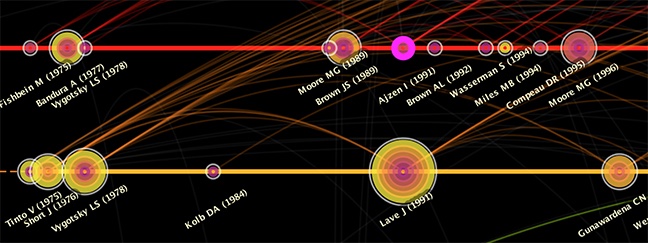
However, in terms of the overall timeline analysis, the biggest impact has been that of Garrison et al. (2000) who introduced the community of inquiry model and its components, namely social, teaching, and cognitive presences. Another study by the same authors (Garrison et al., 2001) maintained the legacy of the CoI. In terms of theoretical contributions, Siemens’ (2005) work on connectivism was another milestone, as it indicated a shift in attention to networked learning. Following these developments and capacity increase in delivery modes, MOOCs emerged as an evolved form of DE and online learning (see Daniel, 2012; Ho et al., 2014; Kizilcec et al., 2013; Liyanagunawardena et al., 2013; Yuan & Powell, 2013). Open educational resources have contributed to forging open practices and open pedagogy (Atkins et al., 2007; see Figure 4 and Figure 6).
Figure 6
Snapshots of Timeline Visualization From 2000 to 2020

*Note. Click here for a larger version.
In parallel with the development of DE, we observed pivotal contributions related to EdTech. A pioneering theoretical contribution was by Davis (1989) who introduced the TAM, which was followed by pioneering theoretical contribution by Venkatesh et al. (2003). After the first decade of the 2000s, the focal point was online learning and online learners (Allen & Seaman, 2013; Braun, 2008), and e-learning became part of mainstream education (Garrison, 2011; see Figure 4 and Figure 7).
Figure 7
Snapshots of Timeline Visualization From 1990s to 2010s
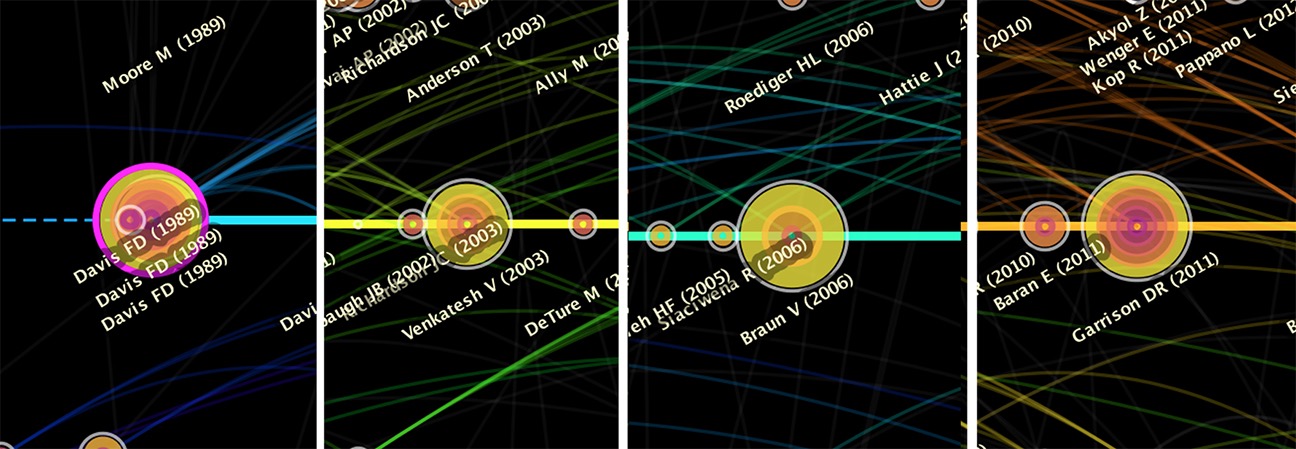
To summarize, it can be argued that DE evolved by incorporating social learning theories and, starting in the 1990s, the field has focused on CMC (e.g., interaction and presence types, as well as online community formation). This focus was followed by the emergence of ubiquitous learning opportunities offered by distributed and networked online DE. Confirming the findings of Bozkurt (2020), it is noteworthy that since the 2000s, the fields of DE and EdTech have exhibited points of intersection and have advanced by triggering innovations in each other. The dawn of the 21st century witnessed a swift and dramatic transformation of DE, when online learning emerged as the “new face of distance education” (Zawacki-Richter & Naidu, 2016, p. 258). It should be noted that the emergence, rise, and success of online learning (with its relatively short history), is a consequence of the long and distilled theoretical and practical body of knowledge in the broader field of DE.
This study provides orientation and new insights into the scholarly structure of DE as an academic discipline. Our findings demonstrate that research in the period from 2014 to 2019 published in leading DE journals focused on three broad areas:
Our findings show that published DE research has been clearly dominated by studies in the higher education context. Moving further into the mainstream of education—especially in times such as the global COVID-19 pandemic—we recommend that DE researchers should also turn their attention and transfer knowledge and experience to the K-12 school context. This would support teachers and parents, and prevent them having to re-invent the wheel when adopting remote teaching and homeschooling practices. Furthermore, the results of this study suggest there is very little research that considers learning with digital media in non-formal settings (see Latchem, 2018).
The field of online DE research has been developing dynamically in the era of digital transformation. With the need for emergency remote education (Bozkurt & Sharma, 2020a; Hodges et al., 2020) in the current COVID-19 pandemic, the roots of online learning and teaching (namely theory, practice, and empirical research in the broader field of DE) have gained added relevance. It is crucial to build on and relate to this theory, practical experiences, and knowledge, especially for researchers and practitioners who venture into the field of online distance education.
DE research is well-grounded in foundational theories such as adult learning theory, self-directed learning theory, as well as emerging theories. The discipline of DE (most prominently the CoI framework and the theory of connectivism) has not only spawned new theories, but has also borrowed theories from related fields, such as media theory, instructional design theory, and motivation theory (see an overview in Jung, 2019).
For generations, DE has skillfully served to balance inequity, address the knowledge gap, and democratize education. However, we are on the verge of a major transformation due to the COVID-19 pandemic, which has been called the great reset, and there is now a new/next normal and a new order all around the world (Bozkurt & Sharma, 2020b). In addition to the effects of the pandemic, the world is being decentralized, learners are coming from increasingly diverse backgrounds, learning is emerging as a liminal process, learning sources are being distributed across online and offline networks, and—most importantly—the nature of the learning ecology is evolving. We, therefore, need to redefine our roles, take on new responsibilities, and embrace them. As distance educators, we should ask ourselves how we envision the future and how well we are prepared for tomorrow’s learning landscape. In this regard, it is more critical than ever to ask what our research agenda will be in the changing world. This study suggests that the role of DE is more significant than ever and there is a need to develop new policies and strategies; it is critical to identify a proactive research agenda to better respond to changes, to be resilient, and to meet ongoing and sometimes sudden challenges in terms of educational needs.
Allen, I. E., & Seaman, J. (2013). Changing course: Ten years of tracking online education in the United States. Sloan Consortium. http://www.onlinelearningsurvey.com/reports/changingcourse.pdf
Atkins, D. E., Brown, J. S., & Hammond, A. L. (2007). A review of the open educational resources (OER) movement: Achievements, challenges, and new opportunities. William and Flora Hewlett Foundation. https://hewlett.org/wp-content/uploads/2016/08/ReviewoftheOERMovement.pdf
Bandura, A. (1977). Social learning theory. Prentice-Hall.
Berge, Z. L., & Mrozowski, S. (2001). Review of research in distance education, 1990 to 1999. American Journal of Distance Education, 15(3), 5-19. https://doi.org/10.1080/08923640109527090
Bozkurt, A. (2019). Intellectual roots of distance education: A progressive knowledge domain analysis. Distance Education, 40(4), 497-514. https://doi.org/10.1080/01587919.2019.1681894
Bozkurt, A. (2020). Educational technology research patterns in the realm of the digital knowledge age. Journal of Interactive Media in Education, 2020(1), 1-17. https://doi.org/10.5334/jime.570
Bozkurt, A., Akgun-Ozbek, E., Onrat-Yilmazer, S., Erdogdu, E., Ucar, H., Guler, E., Sezgin, S., Karadeniz, A., Sen-Ersoy, N., Goksel-Canbek, N., Dincer, G. D., Ari, S., & Aydin, C. H. (2015). Trends in distance education research: A content analysis of journals 2009-2013. International Review of Research in Open and Distributed Learning, 16(1), 330-363. http://dx.doi.org/10.19173/irrodl.v16i1.1953
Bozkurt, A., & Sharma, R. C. (2020a). Emergency remote teaching in a time of global crisis due to CoronaVirus pandemic. Asian Journal of Distance Education, 15(1), i-vi. https://doi.org/10.5281/zenodo.3778083
Bozkurt, A., & Sharma, R. C. (2020b). Education in normal, new normal, and next normal: Observations from the past, insights from the present and projections for the future. Asian Journal of Distance Education, 15(2), i-x. https://doi.org/10.5281/zenodo.4362664
Braun, T. (2008). Making a choice: The perceptions and attitudes of online graduate students. Journal of Technology and Teacher Education, 16(1), 63-92. https://www.learntechlib.org/primary/j/JTATE/
Çakiroğlu, Ü., Kokoç, M., Gökoğlu, S., Öztürk, M., & Erdoğdu, F. (2019). An analysis of the journey of open and distance education: Major concepts and cutoff points in research trends. The International Review of Research in Open and Distributed Learning, 20(1), 1-20. https://doi.org/10.19173/irrodl.v20i1.3743
Chen, C. (2006). CiteSpace II: Detecting and visualizing emerging trends and transient patterns in scientific literature. Journal of the American Society for Information Science and Technology, 57(3), 359-377. https://doi.org/10.1002/asi.20317
Conley, Q., Lutz, H. S., & Padgitt, A. J. (2017). Creating participatory online learning environments: A social learning approach revisited. Journal of Interactive Learning Research, 28(1), 5-27. https://eric.ed.gov/?id=EJ1133397
Dalsgaard, C., & Thestrup, K. (2015). Dimensions of openness: Beyond the course as an open format in online education. The International Review of Research in Open and Distributed Learning, 16(6), 78-97. https://doi.org/10.19173/irrodl.v16i6.2146
Daniel, J. (2012). Making sense of MOOCs: Musings in a maze of myth, paradox and possibility. Journal of Interactive Media in Education, 2012(3). https://doi.org/10.5334/2012-18
Davis, F. D. (1989). Perceived usefulness, perceived ease of use, and user acceptance of information technology. MIS Quarterly, 13, 319-339. https://doi.org/10.2307/249008
Dillon, C. L., Gunawardena, C. N., & Parker, R. (1992). Learner support: The critical link in distance education. Distance Education, 13(1), 29-45. https://doi.org/10.1080/0158791920130104
Fayyad, U., Grinstein, G. G., & Wierse, A. (Eds.). (2002). Information visualization in data mining and knowledge discovery. Morgan Kaufmann.
Feldman, R., & Sanger, J. (2007). The text mining handbook: Advanced approaches in analyzing unstructured data. Cambridge University Press.
Fisher, M., & Baird, D. E. (2005). Online learning design that fosters student support, self‐regulation, and retention. Campus-Wide Information Systems, 22(2), 88-107. https://doi.org/10.1108/10650740510587100
Garfield, E. (1972). Citation analysis as a tool in journal evaluation. Science, 178, 471-479. http://dx.doi.org/10.1126/science.178.4060.471
Garrison, D. R. (2011). E-learning in the 21st century: A framework for research and practice. Routledge.
Garrison, D. R., Anderson, T., & Archer, W. (2000). Critical inquiry in a text-based environment: Computer conferencing in higher education. The Internet and Higher Education, 2, 87-105. https://doi.org/10.1016/S1096-7516
Garrison, D. R., Anderson, T., & Archer, W. (2001). Critical thinking, cognitive presence, and computer conferencing in distance education. American Journal of Distance Education, 15, 7-23. https://doi.org/10.1080/08923640109527071
Garrison, D. R., & Kanuka, H. (2004). Blended learning: Uncovering its transformative potential in higher education. The Internet and Higher Education, 7(2), 95-105. https://doi.org/10.1016/j.iheduc.2004.02.001
Gomes, R. R., & Barbosa, M. W. (2018). An analysis of the structure and evolution of the distance education research area community in terms of coauthorships. International Journal of Distance Education Technologies, 16(2), 65-79. https://doi.org/10.4018/IJDET.2018040105
Hansen, D., Shneiderman, B., & Smith, M. A. (2010). Analyzing social media networks with NodeXL: Insights from a connected world. Morgan Kaufmann.
Ho, A. D., Reich, J., Nesterko, S., Seaton, D. T., Mullaney, T., Waldo, J., & Chuang, I. (2014). HarvardX and MITx: The first year of open online courses. Working Paper No. 1. Harvard University.
Hodges, C., Moore, S., Lockee, B., Trust, T., & Bond, A. (2020, March 27). The difference between emergency remote teaching and online learning. EDUCAUSE Review. https://er.educause.edu/articles/2020/3/the-difference-between-emergency-remote-teaching-and-online-learning
Jung, I. (Ed.). (2019). Open and distance education theory revisited: Implications for the digital era. Springer.
Keegan, D. (1980). On defining distance education. Distance Education, 1(1), 13-36. https://doi.org/10.1080/0158791800010102
Kizilcec, R. F., Piech, C., & Schneider, E. (2013, April). Deconstructing disengagement: Analyzing learner subpopulations in massive open online courses. Proceedings of the Third International Conference on Learning Analytics and Knowledge (pp. 170-179). https://doi.org/10.1145/2460296.2460330
Koseoglu, S., Bozkurt, A., & Havemann, L. (2020). Critical questions for open educational practices. Distance Education, 41(2). 153-155. https://doi.org/10.1080/01587919.2020.1775341
Lambert, S. R. (2020). Do MOOCs contribute to student equity and social inclusion? A systematic review 2014-18. Computers & Education, 145, 103693. https://doi.org/10.1016/j.compedu.2019.103693
Latchem, C. R. (2018). Open and distance non-formal education in developing countries. Springer. https://doi.org/10.1007/978-981-10-6741-9
Lave, J., & Wenger, E. (1991). Situated learning: Legitimate peripheral participation. Cambridge University Press.
Lee, Y., Driscoll, M. P., & Nelson, D. W. (2004). The past, present, and future of research in distance education: Results of a content analysis. The American Journal of Distance Education, 18(4), 225-241. https://doi.org/10.1207/s15389286ajde1804_4
Lemoine, P. A., & Richardson, M. D. (2015). Micro-credentials, nano degrees, and digital badges: New credentials for global higher education. International Journal of Technology and Educational Marketing, 5(1), 36-49. https://doi.org/10.4018/ijtem.2015010104
Liyanagunawardena, T. R., Adams, A. A., & Williams, S. A. (2013). MOOCs: A systematic study of the published literature 2008-2012. The International Review of Research in Open and Distributed Learning, 14(3), 202-227. https://doi.org/10.19173/irrodl.v14i3.1455
Luo, T., Hostetler, K., Freeman, C., & Stefaniak, J. (2019). The power of open: Benefits, barriers, and strategies for integration of open educational resources. Open Learning: The Journal of Open, Distance and e-Learning, 35(2), 1-19. https://doi.org/10.1080/02680513.2019.1677222
Mishra, S. (2017). Open educational resources: Removing barriers from within. Distance Education, 38(3), 369-380. https://doi.org/10.1080/01587919.2017.1369350
Moore, M. G. (1989). Editorial: Three types of interaction. American Journal of Distance Education, 3(2), 1-7. https://doi.org/10.1080/08923648909526659
Moore, M. G., & Kearsley, G. (2012 ). Distance education: A systems view of online learning. Cengage.
Naidu, S. (2019). Forty years of pushing the boundaries of education. Distance Education, 40( 4), 425-429. https://doi.org/10.1080/01587919.2019.1693952
O’Connell, J. (2016). Networked participatory online learning design and challenges for academic integrity in higher education. International Journal for Educational Integrity, 12(1). https://doi.org/10.1007/s40979-016-0009-7
Perraton, H. (2000). Rethinking the research agenda. International Review of Research in Open and Distributed Learning, 1(1). https://doi.org/10.19173/irrodl.v1i1.5
Robinson, H., Al-Freih, M., & Kilgore, W. (2020). Designing with care: Towards a care-centered model for online learning design. International Journal of Information and Learning Technology, 37(3), 99-108. https://doi.org/10.1108/IJILT-10-2019-0098
Scott, J. (2017). Social network analysis (4th ed.). Sage.
Short, J., Williams, E., & Christie, B. (1976). The social psychology of telecommunications. John Wiley & Sons.
Siemens, G. (2005). Connectivism: A learning theory for the digital age. eLearnspace. http://www.elearnspace.org/Articles/connectivism.htm
Sim, K. N. (2017). Researching distance education: A possibility to humanize it. In M. Northcote & K. Gosselin (Eds.), Handbook of research on humanizing the distance learning experience (pp. 26-47). IGI Global. http://doi:10.4018/978-1-5225-0968-4.ch002
Smith, A. E., & Humphreys, M. S. (2006). Evaluation of unsupervised semantic mapping of natural language with Leximancer concept mapping. Behavior Research Methods, 38(2), 262-279. https://doi.org/10.3758/BF03192778
Tait, A. (2008). What are open universities for? Open Learning, 23(2), 85-93. https://doi.org/10.1080/02680510802051871
Thurmond, V. A. (2001). The point of triangulation. Journal of Nursing Scholarship, 33(3), 253-258. https://doi.org/10.1111/j.1547-5069.2001.00253.x
van der Maaten, L., & Hinton, G. (2008). Visualizing data using t-SNE. Journal of Machine Learning Research, 9( 2008), 2579-2605. http://www.jmlr.org/papers/volume9/vandermaaten08a/vandermaaten08a.pdf
Venkatesh, V., Morris, M. G., Davis, G. B., & Davis, F. D. (2003). User acceptance of information technology: Toward a unified view. MIS Quarterly, 27, 425-478. https://doi.org/10.2307/30036540
Vygotsky, L. S. (1978). Mind in society: The development of higher psychological processes. Harvard University Press.
Xiao, J. (2018). On the margins or at the center? Distance education in higher education. Distance Education, 39(2), 259-274. https://doi.org/10.1080/01587919.2018.1429213
Youssef, L. (2014). Globalisation and higher education: From within-border to cross-border. Open Learning: The Journal of Open, Distance and e-Learning, 29(2), 100-115. https://doi.org/10.1080/02680513.2014.932686
Yuan, L., & Powell, S. (2013). MOOCs and open education: Implications for higher education. Centre for Educational Technology & Interoperability Standards. https://publications.cetis.org.uk/wp-content/uploads/2013/03/MOOCs-and-Open-Education.pdf
Zainuddin, Z., & Halili, S. H. (2016). Flipped classroom research and trends from different fields of study. The International Review of Research in Open and Distributed Learning, 17(3), 313-340. https://doi.org/10.19173/irrodl.v17i3.2274
Zawacki-Richter, O., & Anderson, T. (2011). The geography of distance education: Bibliographic characteristics of a journal network. Distance Education, 32, 441-456. https://doi.org/10.1080/01587919.2011.610287
Zawacki-Richter, O., & Latchem, C. (2018). Exploring four decades of research in Computers & Education. Computers & Education, 122, 136-152. https://doi.org/10.1016/j.compedu.2018.04.001
Zawacki-Richter, O., & Naidu, S. (2016). Mapping research trends from 35 years of publications in Distance Education. Distance Education, 37(3), 245-269. https://doi.org/10.1080/01587919.2016.1185079
Zawacki-Richter, O., Baecker, E. M., & Vogt, S. (2009). Review of distance education research (2000 to 2008): Analysis of research areas, methods, and authorship patterns. International Review of Research in Open and Distributed Learning, 10(6), 21-50. https://doi.org/10.19173/irrodl.v10i6.741
Zawacki-Richter, O., Conrad, D., Bozkurt, A., Aydin, C. H., Bedenlier, S., Jung, I., Stöter, J., Veletsianos, G., Blaschke, L. M., Bond, M., Broens, A., Bruhn, E., Dolch, C., Kalz, M., Kondakci, Y., Marin, V., Mayrberger, K., Müskens, W., Naidu, S.,... Xiao, J. (2020). Elements of open education: An invitation to future research. International Review of Research in Open and Distributed Learning, 21(3), 319-334. https://doi.org/10.19173/irrodl.v21i3.4659

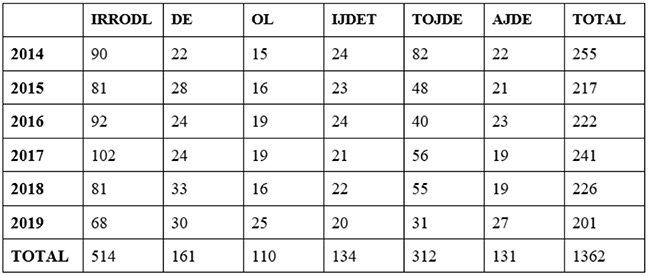
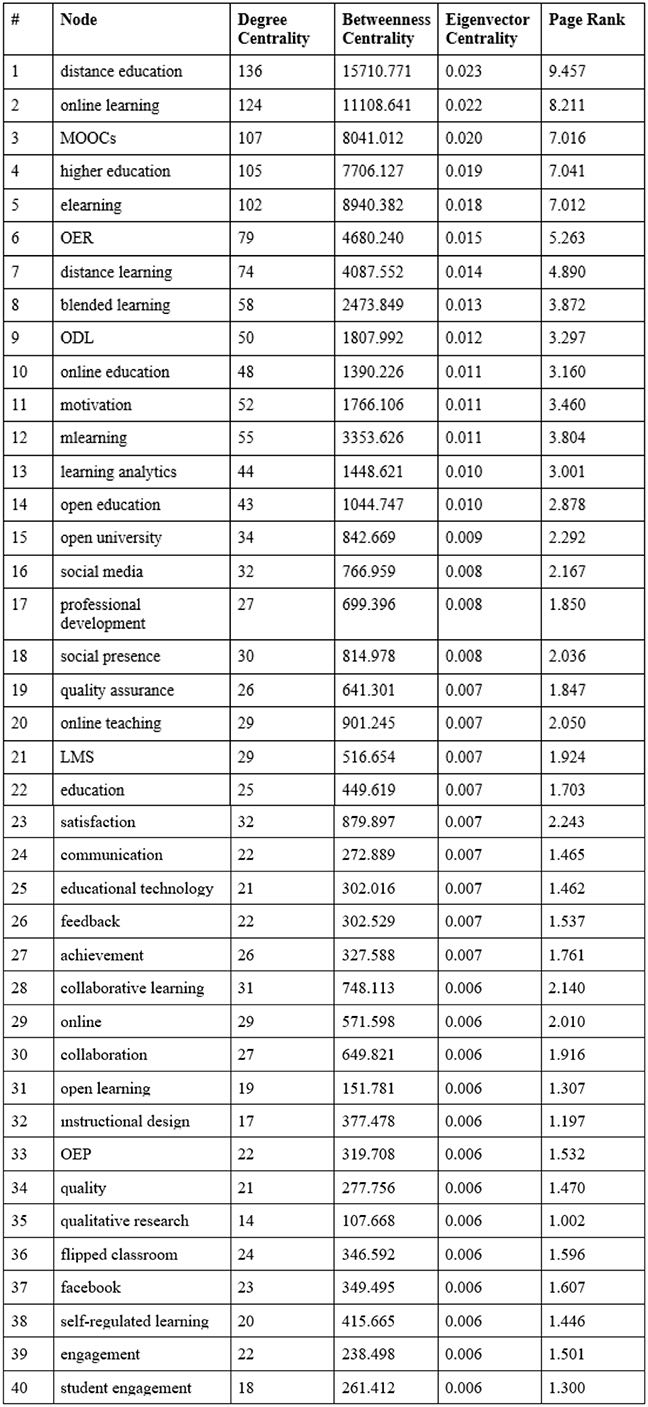

Trends and Patterns in Distance Education (2014-2019): A Synthesis of Scholarly Publications and a Visualization of the Intellectual Landscape by Aras Bozkurt and Olaf Zawacki-Richter is licensed under a Creative Commons Attribution 4.0 International License.